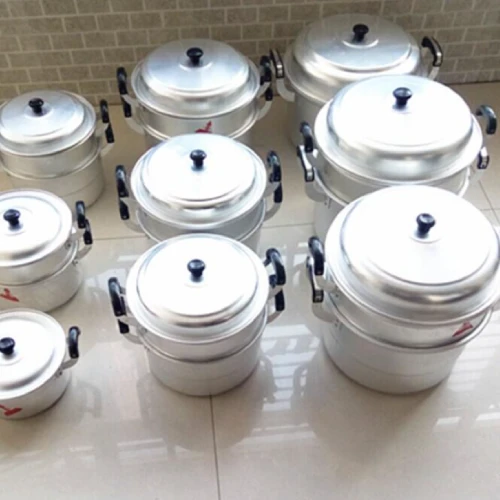If you’re a kitchen beginner, you might see an aluminum pot as just another tool for boiling water or frying eggs. But beneath its simple exterior lies a world of hardcore technology that makes it a staple in kitchens around the globe. From the way it’s made to the features that keep it performing well, aluminum pots are a blend of science and innovation. Let’s dive into the secrets that turn a basic piece of cookware into a high-tech kitchen essential.

The Material: Lightweight Yet Mighty
Aluminum is the star of the show when it comes to these pots, and it’s not just because it’s lightweight. This metal has some unique properties that make it perfect for cooking:
Exceptional Heat Conductivity: Aluminum heats up quickly and distributes heat evenly across the surface of the pot. Think about it—when you’re in a rush to make dinner, you don’t want to wait ages for the pan to heat up. Aluminum’s ability to conduct heat means your food cooks faster and more evenly, reducing the chances of hot spots that can burn your meal.
Lightweight Design: Carrying a heavy cast-iron pot can be a struggle, especially for those new to cooking. Aluminum pots are much lighter, making them easy to lift, pour, and maneuver. Whether you’re a student cooking in a tiny dorm kitchen or a busy parent juggling multiple tasks, the lightweight nature of aluminum pots is a huge plus.
But raw aluminum has a problem—it reacts with acidic foods, which can affect the taste of your meals and damage the pot. So, how do manufacturers solve this? The answer lies in surface treatments.
Surface Treatments: Protecting and Enhancing
Anodizing: Creating a Super Shield
One of the most common surface treatments for aluminum pots is anodizing. This process involves creating a thick, protective oxide layer on the surface of the aluminum. It’s like giving the pot a suit of armor that not only prevents it from reacting with food but also makes it more resistant to scratches and wear.
Here’s how it works: the aluminum pot is placed in an electrolyte solution and then connected to an electric current. This causes oxygen to bond with the aluminum, forming a durable oxide layer. Anodized aluminum pots are great for everyday use, as they can handle acidic ingredients like tomatoes and vinegar without any issues. Plus, the anodized surface can be dyed in different colors, adding a touch of style to your kitchen.
Non-Stick Coatings: The Secret to Effortless Cooking
For many kitchen beginners, the fear of food sticking to the pan is real. That’s where non-stick coatings on aluminum pots come in. The most well-known non-stick coating is Teflon, which is made from a material called polytetrafluoroethylene (PTFE).
Teflon creates a smooth, slippery surface that prevents food from sticking. Whether you’re making a delicate omelette or frying bacon, you can easily flip and remove your food without scraping the pan. But modern non-stick coatings go beyond just Teflon. Some manufacturers use multi-layer coatings that are more durable and scratch-resistant. These coatings often combine different materials to provide long-lasting non-stick performance, making cooking and cleaning a breeze for even the least experienced cooks.
Design Innovations: Making Cooking Easier
Aluminum pots aren’t just about the material and the coating—their design also plays a crucial role. Manufacturers use clever engineering to make these pots more user-friendly:
Heat-Resistant Handles: Have you ever burned your hand while grabbing a hot pot handle? Most aluminum pots come with heat-resistant handles made from materials like silicone or bakelite. These handles stay cool to the touch, even when the pot is sizzling on the stove, allowing you to move the pot safely without the risk of burns.
Pour Spouts: Precision pouring is important, especially when you’re making sauces or gravies. Many aluminum pots feature specially designed pour spouts that prevent drips and spills. This simple design element can make a big difference, especially for those still mastering the art of cooking.
Lid Design: The lids of aluminum pots are also designed with functionality in mind. Some lids have steam vents that release excess steam, preventing boil-overs. Others have see-through glass windows, so you can check on your food without lifting the lid and losing heat.
Real-World Impact: From Home Kitchens to Professional Restaurants
The high-tech features of aluminum pots aren’t just beneficial for kitchen beginners—they’re also widely used in professional kitchens. Chefs appreciate the fast heat-up times and even heat distribution, which are essential for creating consistent, delicious dishes. The lightweight design makes it easier for them to work long hours without fatigue, while the non-stick coatings reduce the time spent on cleaning up after a busy service.
In home kitchens, these features make cooking more accessible and enjoyable for everyone. Whether you’re trying out a new recipe for the first time or just making a quick meal after a long day, an aluminum pot with its hidden high-tech features can be your reliable cooking companion.
The Future of Aluminum Pots
As technology continues to advance, we can expect even more innovations in aluminum cookware. Researchers are exploring new materials and coatings that are even more durable, eco-friendly, and efficient. For example, some companies are developing non-stick coatings that are free from potentially harmful chemicals, giving consumers peace of mind while they cook.
In conclusion, aluminum pots are far more than meets the eye. Behind their simple appearance is a world of high-tech solutions that make cooking easier, faster, and more enjoyable. The next time you reach for an aluminum pot in your kitchen, remember the science and innovation that went into making it the perfect cooking tool—even if you’re just a kitchen beginner.

